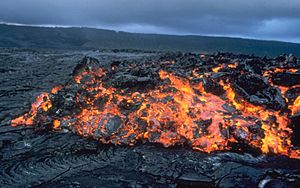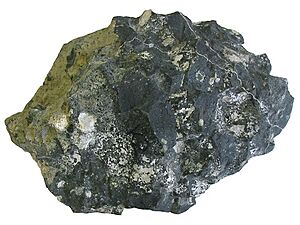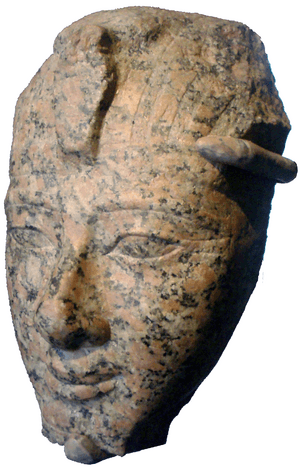Igneous rock facts for kids
Igneous rocks are one of the three main types of rocks found on Earth. The other two are sedimentary and metamorphic rock.
Igneous rocks form from very hot, melted rock material called magma. This magma is found deep inside the Earth, heated by the Earth's mantle.
When magma comes out onto the Earth's surface, it is called lava. Lava cools down quickly to form rocks like tuff and basalt. Some igneous rocks form when magma cools slowly underground. These are called intrusive rocks. Granite is a good example of an intrusive rock.
Contents
Why Igneous Rocks Are Important
About 95% of the Earth's top 16 kilometers (10 miles) of crust is made of igneous rocks. Sedimentary and metamorphic rocks usually form a thinner layer on top.
Igneous rocks are very important for understanding our planet because:
- We can find out their exact age using special dating methods. This helps us figure out the age of other rock layers nearby.
- Their features often tell us about the tectonic environment where they formed. This helps scientists understand how Earth's plates move.
- Sometimes, they contain valuable mineral deposits. For example, tungsten, tin, and uranium are often found with granites. Chromium and platinum can be found with gabbros.
Two Main Types of Igneous Rocks
Igneous rocks form in two main ways:
- Intrusive igneous rocks form when magma cools and hardens inside the Earth. This cooling process is very slow. Examples include gabbro, diorite, and granite.
- Extrusive igneous rocks form when lava cools and hardens outside the Earth, usually after a volcano erupts. This cooling happens much faster. Examples include basalt, andesite, rhyolite, tuff, obsidian, and pumice.
What is Magma?
Magma is a hot, liquid substance found deep inside the Earth. Most magmas are between 700°C and 1300°C (1292°F and 2372°F). Magma can push into nearby rocks underground, which is called an intrusion. Or it can erupt onto the surface as lava, which is called an extrusion or volcanic activity. Sometimes, it explodes out as pieces of rock called tephra.
Magma is made of melted minerals. When magma cools, the tiny parts (atoms and molecules) of these minerals arrange themselves to form mineral grains. Rocks form when these mineral grains, often crystals, grow together. Granite, diorite, gabbro, and basalt are all types of igneous rock. Quartz is a common mineral in igneous rocks. It is made of silica (SiO2).
Minerals in Igneous Rocks
Most minerals that make up igneous rocks belong to these groups:
The first six minerals listed are called silicates. Oxides are mostly made of iron.
Chemical Types of Igneous Rocks
Igneous rocks can also be grouped by their chemical makeup:
- Mafic rocks are rich in magnesium and iron.
- Felsic rocks are rich in lighter elements like silicon, oxygen, aluminium, sodium, and potassium.
Related Topics
Images for kids
-
Volcanic eruptions of lava are major sources of igneous rocks. (Mayon volcano in the Philippines, erupting in 2009)
-
Natural columns of igneous rock separated from each other by columnar joints, in Madeira
-
Sample of basalt (an extrusive igneous rock), found in Massachusetts
-
Close-up of granite (an intrusive igneous rock) exposed in Chennai, India
-
Gabbro specimen showing phaneritic texture, from Rock Creek Canyon, eastern Sierra Nevada, California
-
Kanaga volcano in the Aleutian Islands with a 1906 lava flow in the foreground
-
A "skylight" hole, about 6 m (20 ft) across, in a solidified lava crust reveals molten lava below (flowing towards the top right) in an eruption of Kīlauea in Hawaii
-
Devils Tower, an eroded laccolith in the Black Hills of Wyoming
-
Columnar jointing in the Alcantara Gorge, Sicily
-
A laccolith of granite (light-coloured) that was intruded into older sedimentary rocks (dark-coloured) at Cuernos del Paine, Torres del Paine National Park, Chile
-
An igneous intrusion cut by a pegmatite dike, which in turn is cut by a dolerite dike
See also
 In Spanish: Roca ígnea para niños
In Spanish: Roca ígnea para niños



















